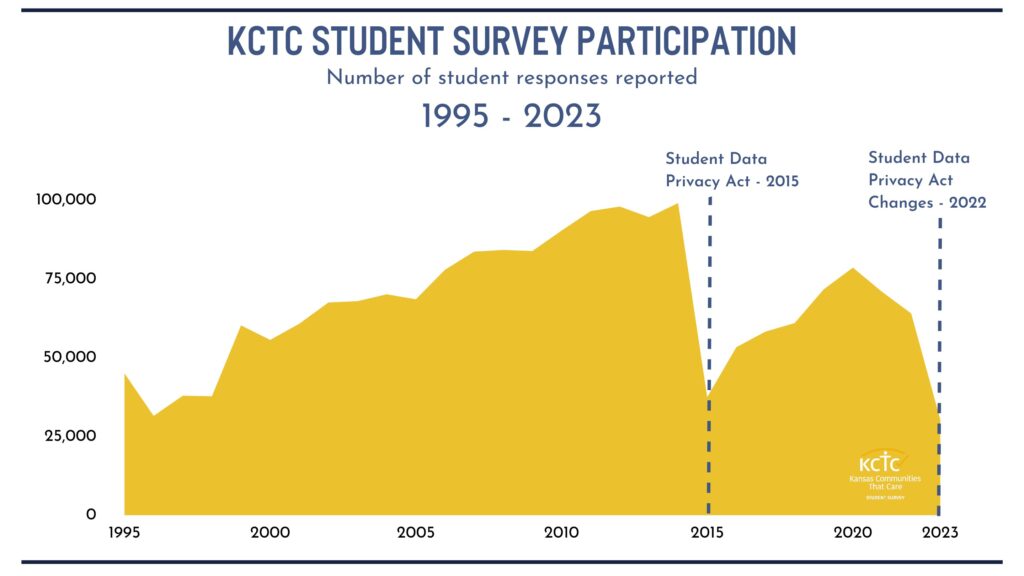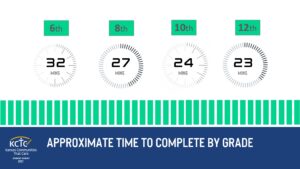Kansas Communities That Care Student Survey Overview and Frequently Asked Questions
- Overview
- Purposes of the KCTC Student Survey
- Frequently Asked Questions
- Survey Rationale and Description of Content
- Risk and Protective Factor Summary
- Contact Us
Overview
The Kansas Communities That Care (KCTC) Student Survey has been administered annually at no cost to districts throughout the state since 1994-1995. The KCTC Survey is making Kansas a national leader for prevention assessment and evaluation.
This survey tracks adolescent use of harmful substances such as alcohol, tobacco, and other drugs. In addition, the survey provides a baseline for adolescent participation in, perception of, and attitudes toward both pro-social and anti-social behavior at the peer, school, family, and community levels. It provides a measurable level of risk and protective factors that influence behavior, attitudes, and opinions of Kansas adolescents.

Purposes of the KCTC Student Survey
- To develop a focus for planning — Reports show Kansas Communities That Care Student Survey data provide an objective profile of problem behaviors,risk andprotective factors that exist in your communities. This information highlights strengths and challenges, which will help in the development of a focused prevention plan. Data from the KCTC Survey is used to help school and community planners assess current conditions and prioritize areas of greatest need. Eachrisk andprotective factor can be linked to specific types of interventions that have been shown to be effective in either reducing risks or enhancing protections. Survey results help schools and communities identify specific areas of concern so they can target strategies which have proven to be most effective in achieving desired results.
- To establish a baseline to track progress — Survey data provides a standardized measure ofrisk andprotective factors and prevalence rates. This data can be used as a baseline for developing measurable outcomes that states and communities choose to target. Future surveys can then be used to track progress toward those outcomes. Data is also used to measure adolescent behaviors, attitudes, and opinions, compared to adolescents in other state and national averages.
- To conduct public relations and outreach — Information from the survey can be used to build public awareness about the extent of problem behaviors and levels of risk and protection. It can help counteract misconceptions and denial about drug and alcohol use and other problem behaviors and provides all stakeholders with a mutual understanding and foundation upon which to make prevention-planning decisions.
For the past 28 years, the Kansas Department for Aging and Disability Services (KDADS) Behavioral Health Services Commission has been dedicated to finding proven strategies and implementing outcomes-based planning in communities. Their hard work and dedication have earned Kansas national recognition and opportunities for continued funding.
Frequently Asked Questions
Greenbush –The Education Service Center, on behalf of the Kansas Department for Aging and Disability Services Behavioral Health Services Commission, will conduct the 2022-2023 survey to gather the information needed to plan important prevention and intervention programs to combat such problems as alcohol and other drug use, bullying, gambling and violence in our schools and communities.
What is the focus of the KCTC Student Survey?
The focus of the KCTC Student Survey is on:
- Health risk behaviors—such as violence, alcohol, tobacco, and other drug use—that can result in injury and/or impede positive development among adolescents
- District-level measures of the KSDE adopted Social, Emotional and Character Development Model Standards
- Local baseline data on adolescent self-reported depression and suicide data to assist with planning for prevention (However, it is not a suicide risk assessment or suicide screening tool.)
- Identifyingrisk factors (predictors of problem behaviors) andprotective factors (predictors of positive adolescent outcomes) which are attitudes and opinions that research has shown to be highly correlated with health risk behaviors
Risk-focused prevention is based on a simple premise: To prevent a problem from happening, we need to identify the factors that increase the risk of that problem developing and then find ways to reduce the risks. Just as medical researchers have found risk factors for heart attacks such as diets high in fats, lack of exercise, and smoking, research (Glaser, et al., 2005; Hawkins, et al., 1992) has defined a set of risk factors for drug abuse.
Why should my school participate?
HELP YOUR SCHOOL DISTRICT: By participating in this survey, your school can:
- Learn more about the specific needs of its students.
- Receive a summary of results broken down by district and school, along with county and statewide results for comparison.
- Use KCTC data to identify areas of need and choose programs and activities to impact these areas.
- Measure and track bullying and school climate/safety issues.
Subsequent surveys are used to determine if the programs and activities that were implemented are having a positive impact. Advantages of the KCTC Student Survey are:
- It helps communities focus their efforts on identified areas of need.
- Because it is a federally approved needs assessment, funders are more likely to look positively on it as an objective tool.
- It helps support grant applications.
There are grant applications that rely on the district’s KCTC participation to collect various data used in the selection process of grant recipients and to track progress toward program goals.
HELP YOUR COMMUNITY: It is not just your district that relies on KCTC data, but many other community programs, community services, and state agencies. To name a few, these include:
- Community coalitions
- The Kansas Prevention Collaborative
- United Way
- Big Brothers/Big Sisters
- Boys & Girls Clubs
- Kansas Children’s Service League
- Communities In Schools
- Juvenile Justice Authority
- Community Mental Health Center Regions
These groups count on annual survey data to apply for and evaluate grant funding that directly or indirectly benefit students, families, and communities. These organizations often assist in providing services based upon needs identified through survey results. The value of these services to schools is incalculable in terms of increasing school attendance, improving the physical and mental health of students, increasing academic achievement and graduation rates, and reducing drop-out rates.
Does my school have to participate?
Participation in this survey is voluntary. Each school has a right to decline participation, just as each student has a right to decline. However, broad participation is needed to obtain accurate estimates and comparisons of these behaviors at state, county, and local levels.
How often should my school participate?
Because we survey 6th, 8th, 10th, and 12th grades, it is important to administer the survey every year to ultimately reach all students. It is also important that all students be given the opportunity to participate. As students move through school and have less structured schedules, it becomes more difficult to make sure that all students receive the opportunity to participate. To determine if prevention activities are successful, annual comparison data is needed. In addition, many community organizations may need annual data for grant evaluation requirements.
How many schools and students participate?
Between 30,000-99,000 surveys are submitted annually from 193-254 Kansas districts and private schools.
Does the 2015 Student Data Privacy Act and 2022 legislative changes to parent consent requirements apply to this survey?
Yes, this act requires written parental consent for surveys administered in schools. An information letter and consent form should be provided to parents of students in the 6th, 8th, 10th, and 12th grades at enrollment (occurring no more than four months prior to survey administration) or at least a month prior to the date of administration. A copy of the survey should be made available to parents. KCTC consent must be collected separately from other surveys, per KCTC Guidance for Changes to Parent Consent Requirements.
Does the Protection of Pupil Rights (PPRA) amendment apply to this survey?
No, PPRA applies only to programs that receive funding from the U.S. Department of Education. Funding for the Kansas Communities That Care Student Survey is provided by the Kansas Department for Aging and Disability Services, Behavioral Health Services Commission.
How do we ensure collection of accurate data?
While the survey instrument is sound, attention and effort at the local level must be given to get accurate data. To ensure that the data collected is truly reflective of the school and community, there must be a high level of participation at all grade levels (80% is recommended). It is important that staff follow the instructions in the protocol and emphasize the importance of the survey. Some suspect that students do not take the survey seriously and therefore do not provide reliable data. We have found that while that may be true in limited instances or when staff do not follow protocol, trend data in Kansas is consistent from year to year, as well as with national data, indicating that kids do answer more honestly than what they might say. All data reported is based upon valid surveys, which are those determined valid after CTC data cleaning protocol and validity checks have been applied.
Are sensitive questions asked?
The survey is designed to measure key behaviors without asking sensitive questions, although it is possible that some schools may consider some questions sensitive. The survey includes questions related to alcohol, tobacco, other drug use, violent behaviors, and related risk and protective factors. There are also optional modules available for family domain questions, depression and suicide questions, demographics for gender identity, and demographics for sexual orientation. Unless questions in these topic areas are asked honestly and directly, we cannot know the degree to which Kansas adolescents engage in these health risk behaviors.
Can I see the survey?
Yes, the survey is available via pdf and online.
Is there more than one version of the survey?
No, there is one KCTC Student Survey containing the core questions. There are also several optional modules available that districts may elect to include.
The KCTC Student Survey core questions – The core survey contains all questions pertaining to CTC risk and protective factors including sections on demographics and school climate, peer influences, drug, alcohol, tobacco usage, and community-based perceptions. It does not contain questions pertaining to family domain, depression and suicide, demographics for gender identity, or demographics for sexual orientation.
What are the four optional modules available?
School districts may elect to include any of the four sets of questions that are not included in the core survey:
- Family Domain Module contains approximately thirty-five questions pertaining to family domain. Family domain questions determine things like a student’s view of parents’ attitudes toward drugs and alcohol. This module will be used to inform the analysis of the contribution of family relationships to other areas of student life and to highlight the important role families play in healthy student development.
- Learn more about why this module is valuable.
- Learn more about why this module is valuable.
- Depression/Suicide Module contains four questions related to depression and suicide ideation and attempt. It is not a suicide risk assessment or suicide screening tool. This module will be used to inform the analysis of the prevalence and trends of self-reported suicide ideation, plans, and attempts. Questions:
- During the past 12 months, did you ever feel so sad or hopeless almost every day for two weeks or more in a row that you stopped doing usual activities?
- Have you ever seriously thought about killing yourself?
- Have you ever made a plan about how you would kill yourself?
- Have you ever tried to kill yourself?
- Demographics for Gender Identity Module contains two demographic questions about birth sex and gender identity. This optional module was updated in 2022-2023 and will be used to inform analysis of substance use, bullying, depression, and suicide among this demographic group. All survey questions are optional for students to respond to at their comfort level. Questions:
- What sex were you assigned at birth?
- What is your current gender identity?
- Demographics for Sexual Orientation Module contains one question about sexual orientation. This optional module was updated in 2022-2023 and will be used to inform analysis of substance use, bullying, depression, and suicide among this demographic group. All survey questions are optional for students to respond to at their comfort level. Questions:
- Which of the following best describes your sexual orientation?

What format is available?
The survey is available online. To administer the survey, all you need is a device with internet connection. Although the survey may be taken from a smart phone, it is not recommended. The survey has been tested on PC, Mac, Chromebook, iPad, Android tablet, iPhones & Android phones. While the survey has been tested on the following web browsers: Chrome, Edge, and Safari. We recommend Google Chrome for compatibility with accessibility apps. We provide a link to the survey. Multiple classes can take the survey on the same devices.
What languages are available?
The survey is available online in both English and Spanish. Students may toggle between languages within the survey.
What if a student does not wish to participate?
Student participation in this survey is completely voluntary. At the beginning of the class period before the survey is administered, the teacher is asked to read a prepared statement that informs the students that their participation is voluntary. These instructions along with the student Informed Consent are embedded in the online survey. Students will be allowed to decline to participate or to skip any question they prefer not to answer. Any student who declines the survey will be provided with an alternative activity while the survey is being administered. Parents also have the option of excusing their child from participation.
Who is eligible to take the survey?
Students in grades 6, 8, 10, and 12 in public and private schools in Kansas are eligible to take the survey.
Are there students who should not participate?
It is not recommended for students who cannot read and comprehend survey questions without assistance to participate in the survey. It is also not recommended for staff to read survey questions aloud to students.
Is student participation anonymous?
Yes, completely.
- Students will not be asked for their names on the survey, nor will anyone be able to connect any individual student with responses.
- School staff will not see any one student’s responses, but only summaries of results.
- Results will not be reported on any question without sufficient response from enough students.
- Privacy is ensured through a sound technology infrastructure along with clear protocols and practices restricting access to key personnel. A password-protected system ensures building- and district-level data are accessible only by individuals approved by each district’s superintendent.
Is there a minimum number required to participate in the survey?
No, there is no minimum to participate. Because we guarantee anonymity for participating students, we do need to have a minimum 25% participation and at least 20 participants per aggregation level, to report data at that level (grade, school, district, county). If participation does not meet these levels, data are not reported on the website but may in some cases be obtained by contacting us directly.
However, districts with low participation rates are included in county and state level reporting.
How long does it take to complete the survey?
The online survey takes approximately 27 minutes for students to complete but will vary by grade level (see right) and student. Allowing a single class period should accommodate students who need additional time to complete the survey. Survey administration cannot be broken up into separate sessions.
When should the survey be administered?
The survey is available for administration between October 2 and January 31. The survey must be administered within four months of collecting parent consent. For best results, the survey should be administered to all schools in the district on the same day. Within a given school, the survey should be administered to all participating grades during the same class period. This will help avoid students from discussing the questions with classmates who have not yet completed the survey and therefore biasing results. Avoid scheduling on Mondays or Fridays because the proximity of these days to the weekend has been shown to affect how students respond to the questions and possibly bias results.
How is the survey coordinated at each school?
Ideally, districts should identify one individual (e.g., a counselor, curriculum director or principal) who will be responsible for coordinating all surveys in the district. This person should then oversee scheduling the survey in applicable classes and communicating this information to teachers. This individual is also responsible for distributing survey links and instructions to schools.
Staff at Greenbush will provide technical assistance and resources upon request. Let us know how we can help you. Contact us at [email protected].
When will results be made available to schools?
Results will be available on kctcdata.org within the spring semester. (If you need specific district data prior to that time, please contact us.) Anyone may view KCTC data aggregated by state, county, Judicial District, and Community Mental Health Center Region. Access specific to the district-or building-level data requires a log-in password. Our password-protected system ensures building and district-level data are accessible only by individuals approved by each district’s superintendent. Districts can also easily create customized reports from the data on the website, comparing their district to county or state averages. District and building summary reports will be posted on the website within the spring semester with some of the more commonly requested data and annual state comparisons.
How will this information be used?
Information from the student survey can be used to meet a variety of needs at community and state levels:
- The survey provides information that can be used to identify the prevalence and trends of various problem behaviors. This information can be used as input for resource and policy planning decisions, such as targeting prevention interventions. Those who receive the information may choose to share it with other community organizations.
- At state and federal levels, there are a variety of competing interests for limited resources. Results of this survey can and have been used to provide evidence for the high priority of those issues that are revealed to be important.
- Community coalitions in your area may be using local KCTC data for grant reporting. Some grants, such as the Drug Free Communities, Kansas Prevention Collaborative Community Initiative (KPCCI), Partnerships for Success, 21st Century Community Learning Centers, and School Climate Transformation, require KCTC participation to collect various data used to track progress toward program goals.
Survey Rationale and Description of Content
The Kansas Communities That Care Student Survey contains questions pertaining to Communities That Care (CTC) risk and protective factors, including sections on demographics & school climate, peer influences, drug, alcohol, tobacco usage, community-based perceptions, and family domain. This document specifies the importance and rationale for including each of these on the survey.
Research (Glaser, et al., 2005; Hawkins, et al., 1992) has provided a great deal of guidance on attitudinal and behavioral factors that place students at great risk for violence and substance use, and those that, on the positive side, provide protection against these unhealthy behaviors. For a complete description of the survey’s risk and protective factors, visit kctcdata.org, click Learn More and About the Survey to view the content linked below An In Depth Look Behind the Scenes.
Section 1: Demographics & School Climate
Some basic background information (for example, age, grade level, ethnic group) is needed to ensure that students participating in the survey are generally representative of the statewide student population. Beginning in the late elementary grades, academic failure increases the risk of both drug abuse and delinquency. However, these analyses are conducted without specific identification of individual students so that anonymity is maintained throughout the survey.
Sample Items:
- How old are you?
- What is the highest level of schooling your father/mother completed?
- During this school year, how often have you been bullied at school?
- At my school, there are opportunities for students to get involved in school activities and other activities outside of class.
Section 2: Peer Influences
Research (Glaser, et al., 2005; Hawkins, et al., 1992) has shown that young people who are socially competent and engage in positive interpersonal relations with their peers are less likely to use drugs and engage in other problem behaviors. This section looks at the things associated with a student’s peers, such as use of drugs/alcohol by a student’s best friends, gang involvement, and interaction with antisocial peers.
Sample Items:
- In the past year, how many of your best friends have sold illegal drugs?
- In the past year, how many of your best friends have been arrested?
Section 3: Alcohol, Tobacco, and Other Drug Use
One of the target behaviors of interest in this survey is the extent to which students have used and are using alcohol, tobacco, marijuana, cocaine, LSD, inhalants, methamphetamines, steroids, and prescription drugs. Asking these questions from year to year allows for local and statewide comparisons of changes in these patterns over time and provides important databased direction for prevention efforts both locally and across the state.
Sample Items:
- In your lifetime, on how many occasions (if any) have you used marijuana?
- Think back over the last two weeks. How many times have you had five or more alcoholic drinks in a row?
Section 4: Community-Based Perceptions
Research (Glaser, et al., 2005; Hawkins, et al., 1992) has shown that such things as legal restrictions on alcohol and tobacco use have been followed by decreases in consumption, and that low levels of bonding to the neighborhood are related to higher levels of juvenile crime and drug selling.
Sample Items:
- Would a kid be caught by the police in the neighborhood or area around where you live if they carried a gun without permission or supervision?
- How wrong would most adults in your neighborhood or area around where you live, think it was for kids your age to smoke cigarettes?
Section 5: Family Domain (Optional)
When adolescents are raised in a family with a history of problem behaviors (e.g., violence or substance use), the children are more likely to engage in these behaviors. Adolescents raised in families high in conflict appear at risk for both delinquency and drug use. On the other hand, young people who feel they are a valued part of their family are less likely to engage in substance use and other problem behaviors.
Sample Items:
- How often do the adults you live with tell you they’re proud of you for something you’ve done?
- Would the adults you live with know if you did not come home on time?
- My family has clear rules about alcohol and drug use.
Risk and Protective Factor Summary
Each of the above domains has its own set of risk and protective factors, which are different combinations of questions as they relate to students, their peers, school, community, and family. Researchers (Glaser, et al., 2005; Hawkins, et al., 1992) have found that an interrelationship exists between adolescent drug abuse, delinquency, school dropout, and violence, and thus were able to identify risk factors for these problems. Then, to prevent problem behaviors from happening, we need to identify and increase the factors that protect against problem behaviors and reduce the factors that increase the risks.
Sample Protective Factor Profiles:
- School Opportunities for Involvement
- Community Rewards for Conventional Involvement
- Family Attachment
Sample Risk Factor Profiles:
- Peer Antisocial Behavior
- Academic Failure
- Availability of Drugs
- Family Conflict
- Parental Attitudes Favorable to Drugs
References
- Glaser, R. R., Van Horn, M. L., Arthur, M. W., Hawkins, J. D. & Catalano, R. F. (2005). Measurement Properties of the Communities That Care Youth Survey across Demographic Groups Journal of Quantitative Criminology, Vol. 21(1), 73-102. DOI: 10.1007/s10940-004-1788-1
- Hawkins, J. D., Catalano, R. F., and Miller, J. Y. (1992). Risk and protective factors for alcohol and other drug problems in adolescence and early adulthood: implications for substance-abuse prevention. Psychol. Bulletin, 112: 64–105.
Contact Us
If you have questions about the survey, visit kctcdata.org, or contact the KCTC Team at Greenbush at [email protected] or call 620-724-6281 ext. 366.
Revised May 2023
SEKESC IRB STUDY#2023-06


